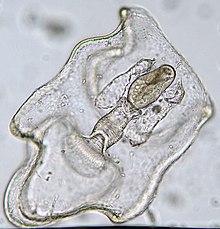Bipinnaria
Abipinnariais the first stage in thelarvaldevelopment of moststarfish,and is usually followed by abrachiolariastage. Movement and feeding is accomplished by the bands ofcilia.Starfish that brood their young generally lack a bipinnaria stage, with the eggs developing directly into miniature adults

The bipinnaria is free-living, swimming as part of thezooplankton.When it initially forms, the entire body is covered by cilia, but as it grows, these become confined to a narrow band forming a number of loops over the body surface. A pair of short, stubby arms soon develop on the body, with the ciliated bands extending into them.
In addition to propelling the larva through the water, the cilia also catch suspended food particles, and deliver them to the mouth (more correctly called astomodeum).
Eventually, three additional arms develop at the front end of the larva; at this point it becomes abrachiolaria.In some species, including the common starfishAsterias,the bipinnaria develops directly into an adult.
It is very similar in appearance to thetornarialarvae of someHemichordata,reflecting the descent of theAmbulacrariafrom a common ancestor.
References[edit]
Barnes, Robert D. (1982).Invertebrate Zoology.Philadelphia, PA:Holt-Saunders International.pp. 945–946.ISBN0-03-056747-5.
